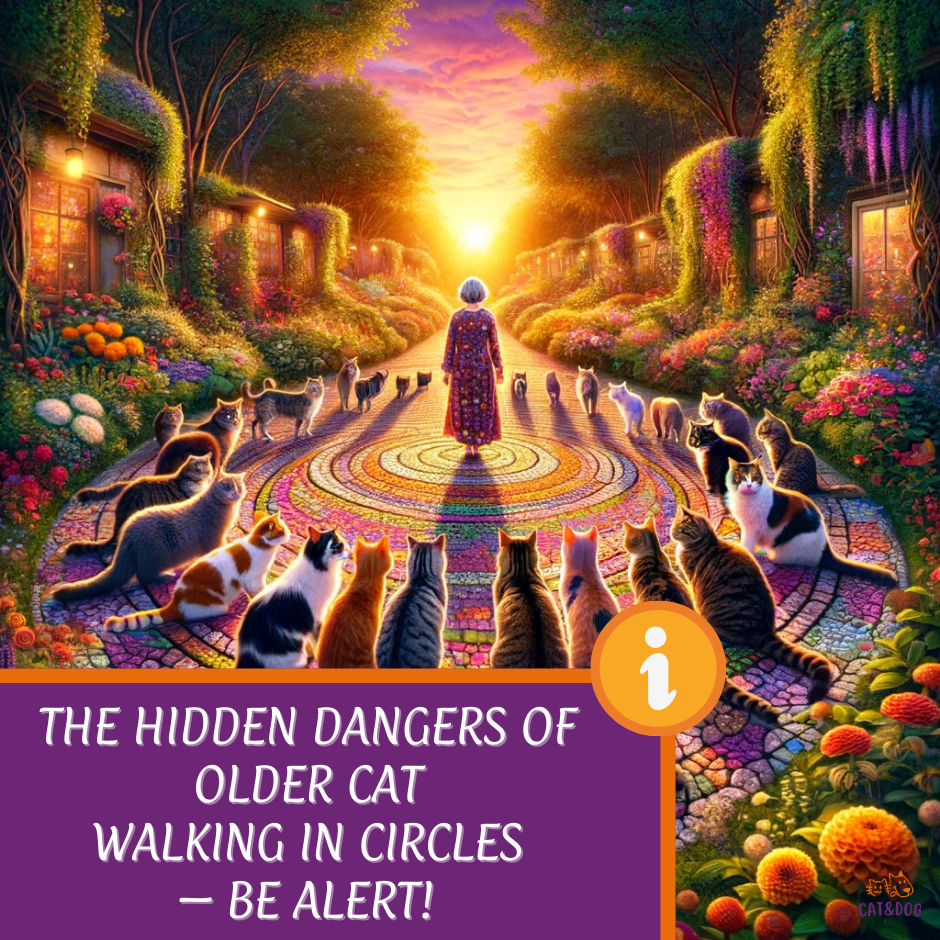Noticing your older cat walking in circles can be a perplexing and worrying sight. You might wonder whether it’s a one-off oddity or a sign of something more serious, such as medical issues.
As our feline friends advance in age, they can develop various health issues, some of which may affect their mobility and orientation.
This article aims to demystify the reasons why older cats may start walking in circles, drawing on a spectrum of causes from neurological problems and brain health to inner ear problems and possible causes of discomfort such as ear infections, brain tumors, and liver disease.
This makes it crucial to seek evaluation from a veterinarian for your old cat, especially if accompanied by other clinical signs, and rule out any other possible causes of discomfort.
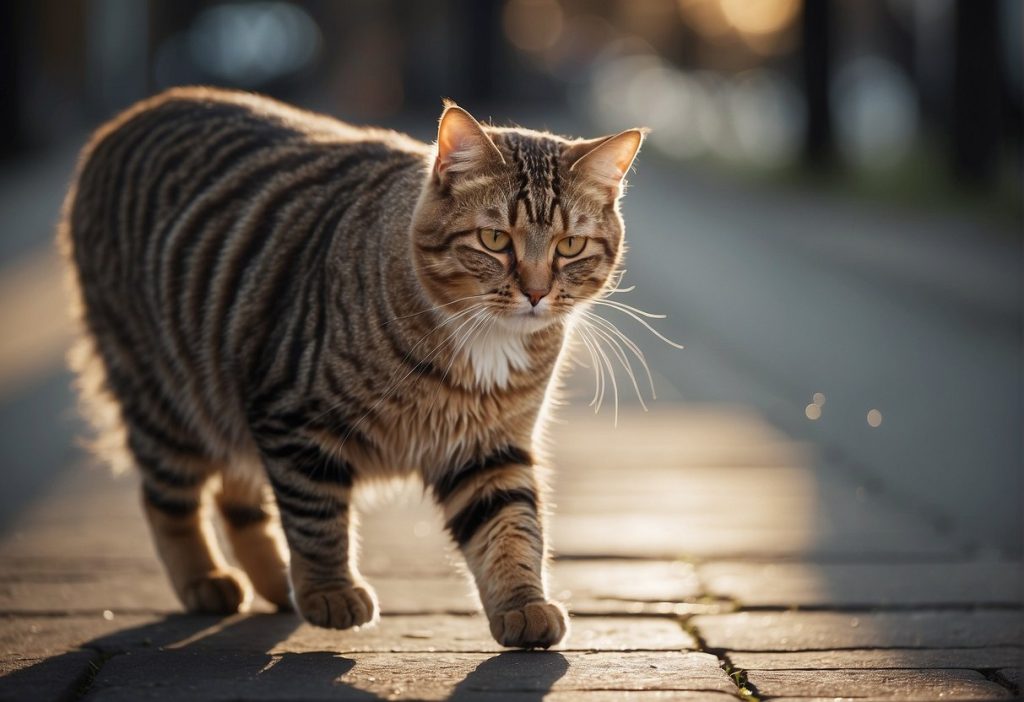
Understanding the behavior is crucial, not only to ensure the well-being of your beloved pet but also to prepare for how to best support them.
We’ll explore immediate care strategies you can employ, delve into the diagnostic process to identify the root cause, and consider both medical and alternative treatment options.
Additionally, the emotional well-being of owners navigating their cat’s healthcare is paramount, and this article will touch upon that aspect too.
With insights from veterinary professionals, real-life anecdotes, and practical tips, you’ll come away with a clearer picture of how to proceed if you find yourself in this situation.
Key Takeaways
- Older cats walking in circles may indicate health issues such as vestibular disease or brain tumors.
- Immediate attention from a veterinarian is essential for diagnosis and establishing proper care.
- Treatment options vary, emphasizing the importance of understanding the specific cause and providing necessary emotional support for both the cat and the owner.
Immediate Care and First Aid for Older Cat Walking in Circles

Recognizing when your furry friend isn’t just chasing its tail in a playful mood but is displaying signs of distress is crucial.
If your older cat is walking in circles, your first move is to stay calm and approach gently. Hasty moves or loud voices might startle them further.
First Steps to Take at Home:
- Approach your cat slowly and speak in a soothing tone.
- Gently examine them for any visible injuries or irregularities.
- Look out for other symptoms like lethargy, uncontrolled vomiting, or a loss of consciousness. These signs scream for immediate vet attention!
Preparing to whisk your cat to the vet can be like herding cats if you’re not prepared. Here’s how to do it with finesse:
- Ensure their carrier is comfortable and secure. A familiar blanket can add a calming scent.
- Keep your tone and body language relaxed—cats are experts at reading stress!
Before you hit the road, let’s make sure you’ve got all your ducks in a row. Well, in this case, all your cat facts:
- Recent behavioral changes? Jot them down.
- Medical history and current meds? Check.
- An episode description? Noted. The vet will be all ears to hear about your cat’s unusual circles.
Remember, this isn’t a cat’s game of hide and seek, so get moving swiftly but without causing alarm.
By showing compassion and understanding, you’ll make this experience less paws-traumatic for both of you.
Prompt attention is crucial in cases of head trauma to minimize damage and increase your cat’s chance of recovery.
Immediate care and first aid are essential for your cat’s well-being, so don’t delay in seeking prompt attention from a veterinarian.
And hey, maybe keep those cat puns for the vet – a little humor never hurt anyone, right?
Understanding Why Older Cats Walk in Circles
It’s a behavior that’s not just mysterious but can be a cause for concern. Let’s unravel this feline mystery together.
Common Causes of Circling in Older Cats
- Cognitive Dysfunction Syndrome (CDS):
Much like humans, cats can experience cognitive decline as they age. Think of it as kitty Alzheimer’s.
The stats are significant; some studies suggest that 28% of pet cats aged 11 to 14 years develop at least one age-related behavior problem which jumps to over 50% for cats 15 years and older. (1) - Inner Ear Infections:
These can throw off anyone’s balance, and cats are no exception. That dizzying feeling can result in circling. But there’s no need to feel round and round about the details! - Neurological Disorders:
Various neurological issues can disrupt a cat’s spatial orientation. It’s a bit like their internal compass goes haywire. (2)
Symptoms to Watch For:
Keep an eye out for these other tell-tale signs:
- Changes in sleep patterns
- Disorientation
- Altered appetite
- Hesitance to jump
Grab a notepad and track these symptoms. Your vet will thank you for this detailed log!
Ready for the vet visit? Don’t circle the issue; these signs warrant a professional look-over. As much as they have nine lives, they need you to ensure each one is purr-fect!
Deep Dive into Cognitive Dysfunction Syndrome (CDS)

Recognizing CDS in Cats
Have you spotted these early signs in your furry friend?
- Disorientation: Struggling to navigate around the house.
- Social Changes: Less cuddly or more irritable around you or other pets.
- Sleep-Wake Disturbance: Prowling around when the moon’s up and snoozing during the day.
- House soiling: Forgetting litter box manners.
An expert indicates, “CDS can significantly affect a cat’s behavior, leading them to show signs of confusion and changes in interaction.”
Managing CDS
While CDS can be a challenge, there are ways to help your cat cope:
- Environmental Tweaks: Keep things consistent to minimize stress. Safety-proof hazardous areas.
- Medication: Your vet might suggest drugs to ease symptoms.
- Special Diets: Nutrient-enriched foods designed for brain health.
- Mental Exercise: Keep their noggin engaged with interactive play.
Case study: An 11-year-old tabby showed improvement through a mix of medication and a stable environment, reducing confusion and helping it enjoy a better quality of life.
Remember, recognizing and managing CDS can make your golden-year kitty comfy and content!
Diagnosing the Cause of Circling
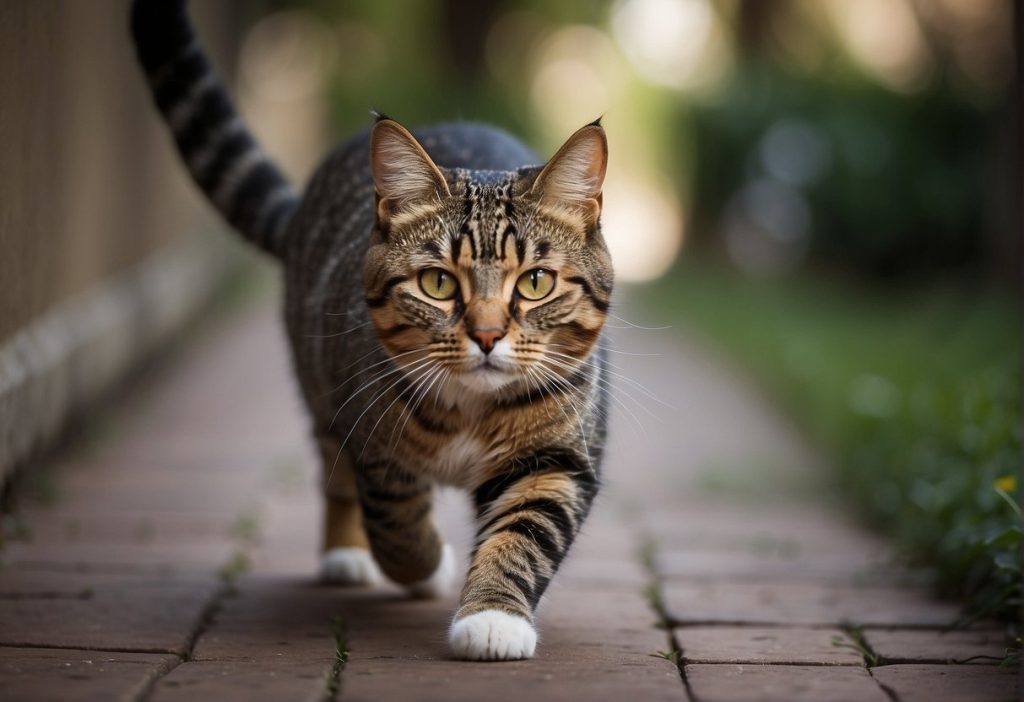
It can seem quirky, but it may signal something that needs a vet’s attention.
When to Visit the Vet:
- Does your cat seem off balance or disoriented?
- Has the circling been happening frequently?
- Are there any other changes in behavior or mobility?
If you nodded yes to any of those, it’s time to give your vet a ring, especially if these symptoms came on suddenly or are increasing in frequency.
Sidebar: Quick Vet Visit Tips
- Jot down any out-of-the-norm behavior.
- Note how often the circling occurs.
Diagnostic Tests: Your vet might suggest a variety of tests.
These could include:
- Blood work: To check for underlying health issues.
- Imaging tests: Such as X-rays or CT scans to peek at your cat’s inner workings.
- Balance tests: To assess vestibular function. (3)
Each test provides a piece of the puzzle for what’s troubling your whiskered companion. Remember, these tests are crucial in creating an accurate diagnosis and a tailored treatment plan.
Got it? Great! Let’s keep your kitty on the straight and narrow, together.
Treatment Options for Older Cats Walking in Circles
Medical Treatments
When your senior cat starts spinning tales by walking in circles, it’s time to look at the medical playbook. Here’s the lowdown:
- Infections:
Just like storm clouds, infections bring trouble. Your vet might prescribe antibiotics or antifungals depending on the culprit. (4)
- Outcomes: Bright skies ahead! Expect improvements with the right meds.
- Side effects: Occasionally, meds might cause a bit of tummy trouble or drowsiness.
- Outcomes: Bright skies ahead! Expect improvements with the right meds.
- Neurological Issues:
These are the trickier critters. Treatments range from anti-inflammatory drugs to surgery for serious conditions like brain tumors. (5)
- Outcomes: Varies from cat to cat; some may regain their straight-line strut.
- Side effects: Sometimes treatments can make your pal a bit wobbly or more sleepy than usual.
- Outcomes: Varies from cat to cat; some may regain their straight-line strut.
Supportive Care at Home
Think of your home as your cat’s kingdom. To keep the Royal Highness safe:
- Remove hazards that can lead to slip-ups or tumbles.
- Nesting spots with cozy blankets can be a haven for rest.
Dietary Changes
Fur-real, diet matters! Depending on the diagnosis, your vet might suggest:
- Omegas & Antioxidants: Boost brain health with foods rich in these. (6)
- Joint Supplements: Help those creaky joints with a sprinkle of glucosamine in the meal.
Remember, it’s not about making the Guinness Book of Cat Records for the longest spinning session. Talk to your vet, tailor your home, and keep the munchies mindful. You’ve got this, fur-parent!
Exploring Alternative Therapies
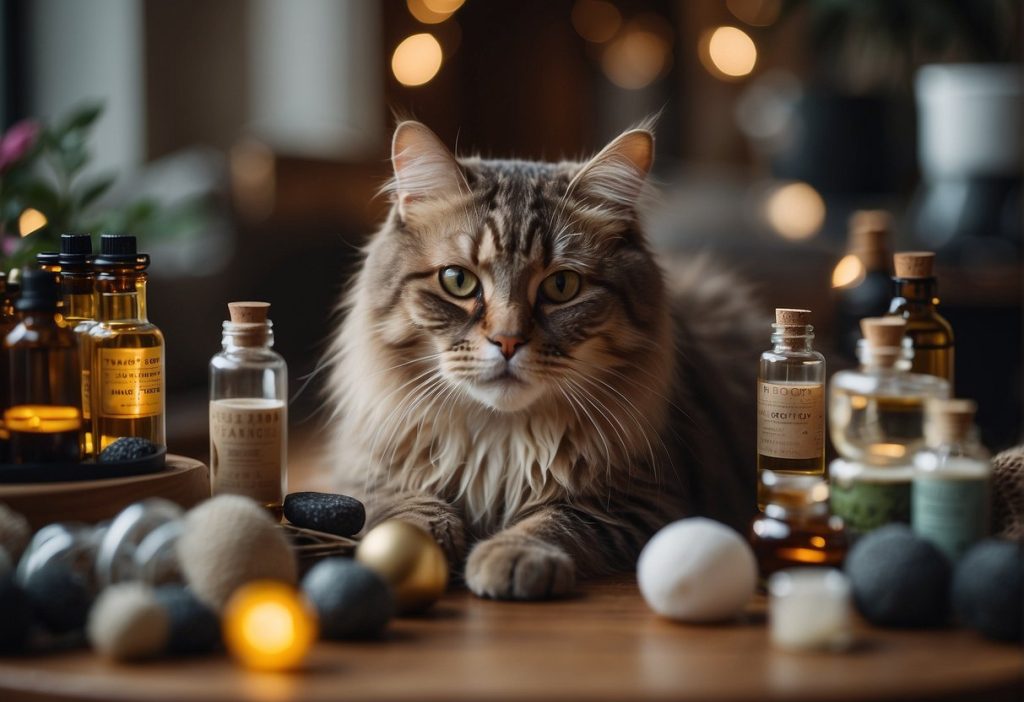
Holistic and Alternative Treatments
Have you heard about acupuncture for cats? Yup, those tiny needles could help your feline friend. (7)
Acupuncture is said to stimulate various points in the body, possibly providing relief for your cat’s anxiety and balance issues.
Physiotherapy is another paw-some option. It includes gentle exercises tailored to your cat’s needs. Imagine it as kitty yoga that soothes their nerves and can make movement easier. (8)
They’re seeing positive results with these therapies when combined with traditional treatments.
Benefits and Considerations
If traditional treatments aren’t doing the trick, it might be time. Just be sure to sniff out those qualified practitioners. Trust me, you don’t want someone winging it on your fur baby.
Consider this:
- Cost: Check your budget. These therapies might not be covered by insurance.
- Availability: Not every vet offers these services, so you might need to do some detective work.
- Individual Response: Each cat is unique, much like us! One may purr with relief, while another remains unimpressed.
Remember, keeping your furry companion comfortable is a journey, not just a destination. Let’s make those golden years as golden as possible! 🐾
Emotional Support for Pet Owners

When you notice your beloved feline friend walking in circles, it’s natural to feel a whirlwind of concern and stress, especially if they have recently experienced a head injury.
Let’s talk about some strategies and resources to support you emotionally during this challenging time, including how to handle a traumatic brain injury or head injury, in your cat’s behavior.
Understanding your cat’s behavior and seeking emotional support for pet owners are crucial steps in caring for a cat with a brain tumor that may affect their behavior.
Additionally, it’s important to monitor your cat’s behavior closely and seek veterinary care if you notice any concerning changes, as a brain tumor can have a significant impact on your cat’s behavior.
If you suspect your cat’s behavior may be due to a brain tumor, it’s important to seek medical attention as soon as possible to ensure proper treatment and care for your cat’s behavior.
Remember, your emotional well-being is just as important as your cat’s physical health during this difficult time, especially when dealing with a brain tumor that can significantly affect your cat’s behavior.
Seeking support and resources, as well as understanding the potential effects on your cat’s behavior, are crucial for both you and your cat’s well-being.
Understanding the potential impact of a brain tumor on your cat’s behavior and seeking emotional support as a pet owner can help you cope with the challenges of caring for your cat.
Remember, you are not alone in this journey and there are resources available to support you and your cat during this difficult time.
If you notice any concerning changes in your cat’s behavior, such as walking in circles, it’s important to seek medical attention and address any potential underlying causes, such as a brain tumor affecting your cat’s behavior.
Understanding and addressing your cat’s behavior is essential for their overall health and well-being, especially if a brain tumor is present
Coping with Your Cat’s Health Issues
Have you found yourself losing sleep over your cat’s health? Sometimes, sharing personal experiences with other cat owners can bring comfort.
It’s therapeutic and a reminder that your feelings are valid. Here’s what you can do to manage emotional stress:
- Talk to people who have been in your shoes.
- Write down your thoughts and feelings in a journal.
- Consider professional mental health support.
Resources for Mental Health Support and Counseling
Your mental well-being is as important as your cat’s health. If the stress becomes overwhelming, don’t hesitate to reach out for help.
Professional counselors can provide a compassionate ear and coping strategies.
Seeking Community Support
You might find solace in online forums or local support groups specifically for pet owners. Here’s a quick guide for finding them:
- Online Forums: Places like Reddit or TheCatSite are filled with fellow pet lovers.
- Local Support Groups: Check community boards at your vet’s office or local shelter.
Hearing how others faced similar issues can be incredibly reassuring.
In conclusion, take care of yourself just as you do for your cat. Lean on these strategies, find community support, and get professional help if needed. Your peace of mind matters.
Preventing Future Health Issues
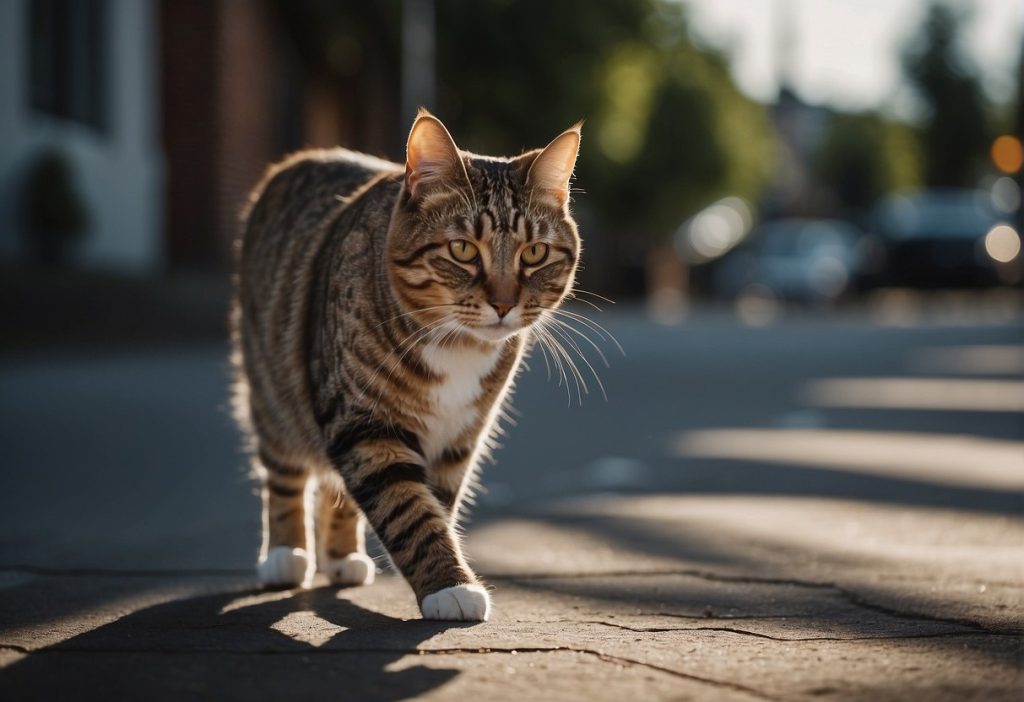
When your older cat starts walking in circles, it’s natural to wonder about their long-term well-being. Let’s get straight to the point: How will this affect your feline friend’s life?
First things first, consult with your vet for a professional outlook. They might tell you that with treatment, many cats continue to lead happy lives.
The specifics, though, will hinge on the underlying cause. Conditions like ear infections can be cleared up, improving your pet’s prognosis significantly.
Now, for something trickier like cognitive dysfunction, which is akin to dementia in humans, management might involve medications and environmental adjustments.
The goal? To maintain a quality of life that keeps your cat’s tail wagging…figuratively speaking, of course. Cats with manageable conditions might live with:
- Close monitoring: Keep tabs on symptoms and behavior changes.
- Treatment compliance: Medications and therapies can be game-changers.
Making informed decisions is key. Your vet should outline treatment options, and together, you’ll weigh benefits against potential side effects. It’s all about keeping your furry companion comfortable.
Let’s tackle the elephant in the room—when do you consider saying goodbye? Well, if your cat’s health deteriorates despite treatment, it’s a conversation to be had.
No one likes to think about it, but sometimes it’s the most compassionate choice.
Remember, you’re not alone. Your vet, perhaps with insights from a veterinary ethicist, can guide you through this tough spot. Is your cat still enjoying life’s little pleasures? Fantastic!
But if pain overtakes pleasure—it might be time to ponder the tough decision.
Ultimately, you know your cat best. Use that loving bond to gauge their happiness and take it one step at a time.
Your cherished pal counts on you to make the right choices for them, and together with your vet, you’ll do just that.
Preventing Future Health Issues
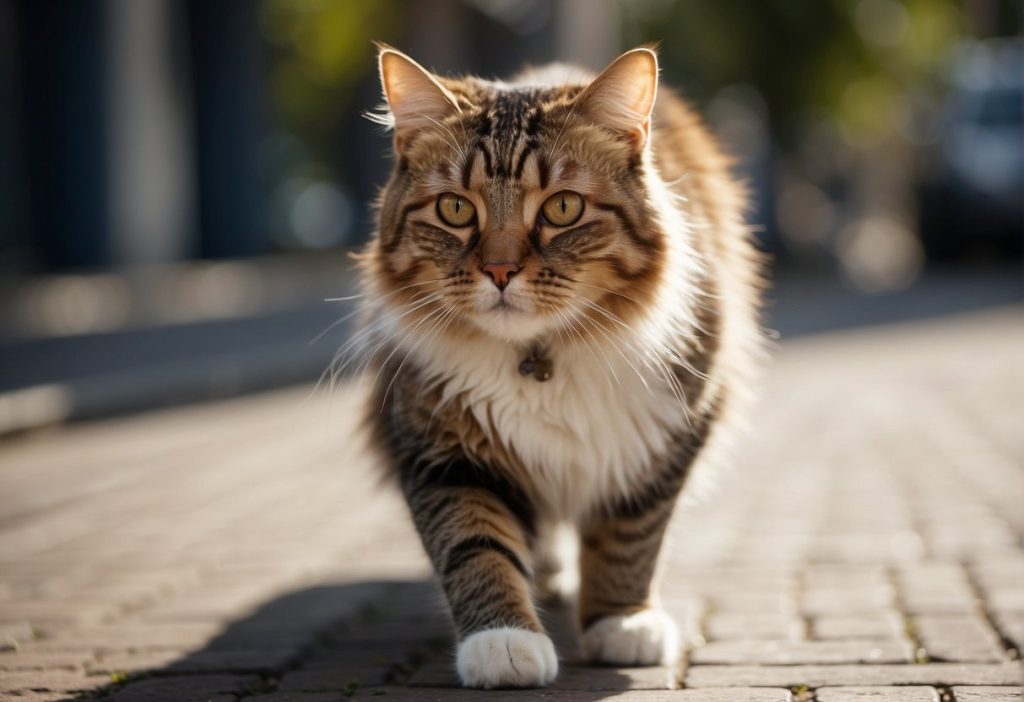
Let’s break it down into bite-sized nuggets of wisdom.
Regular Veterinary Check-ups
Do you know how you do your annual doctor’s appointments? Well, your feline friend deserves the same VIP treatment. Regular vet visits are crucial:
- Early Detection:
It’s not just about vaccines; these check-ups can spot health issues before they spiral, from ear infections to more serious conditions. - Personalized Advice:
A vet can offer you tailored advice for your cat’s unique lifestyle, age, and health.
Here’s a simple chart to keep track:
| Activity | Frequency |
| Routine Check-up | At least annually |
| Blood Work | As recommended |
| Dental Evaluation | Annually |
| Weight Monitoring | Every visit |
Maintaining a Healthy Lifestyle
Just like you feel great after a workout, your older cat stays spry with some regular, gentle exercise. Consider these tips for a vibrant life:
- Nutrition:
Feed your cat age-appropriate, high-quality food. Think of it as their super-elixir for aging gracefully. - Enrichment:
A bored cat is a sluggish cat. Keep their minds sharp with puzzle toys or a window with a view.
Remember, a blend of love, care, and proactive health management can make all the difference. Give your old pal the best shot at a healthy, happy life! 🐾
Quick Recap

Hey there, cat companion! Notice your older kitty walking in circles? It’s enough to make you dizzy with concern. Here’s the scoop:
- Medical Reasons:
Your furry friend might have an ear infection affecting its balance or, in more serious cases, a neurological issue. - Cognitive Decline:
Like humans, cats can experience cognitive changes as they age, sometimes displaying disorientation.
It’s like a mystery novel, and you’re on the case. Can’t figure it out alone? That’s what vets are for!
- Seeking Help: Always consult a vet for a professional verdict.
- Veterinary Actions: Expect a thorough check-up. Your vet might perform balance tests or recommend imaging to peek inside your cat’s noggin.
You’re not in this alone:
- Community: Connect with fellow pet parents. Sharing experiences can be enlightening and comforting.
- Treatments: Various treatments are available, and sometimes it’s about managing symptoms to improve quality of life.
Don’t let the worry whisker you away! Here’s a pat on the back:
- Proactivity Pays Off: Keeping up with your cat’s health screenings can catch issues early on.
- Hope and Healing: With love and care, many cats adapt beautifully to their new normal.
Cheers to many more purrfect days with your senior sidekick! With a bit of know-how and a dash of hope, you two will keep rolling—without the circles.
Frequently Asked Questions
Caring for an aging cat can be both rewarding and challenging. If your feline friend is suddenly walking in circles, you might have concerns about their health.
Let’s tackle some common questions about this behavior and what you might expect.
What are the first signs of Cognitive Dysfunction Syndrome in cats?
Cognitive Dysfunction Syndrome (CDS) in cats can show up as disorientation and behavior changes, with walking in circles being a potential early sign.
This might also include altered sleep-wake cycles and changes in interactions with you or other pets.
How can I make my home safer for a cat with mobility issues?
You can help your cat by keeping floors clear of clutter, securing rugs to prevent slipping, and providing sturdy ramps or steps to their favorite spots.
Ensuring easy access to litter boxes and food bowls can also make a big difference.
Are there any dietary supplements that help with neurological health in cats?
Yes, certain supplements containing antioxidants, Omega-3 fatty acids, and B vitamins may support neurological health in cats.
Always consult your vet before starting any new supplement to ensure it’s right for your pet.
What should I expect during my cat’s veterinary visit for circling behavior?
During the visit, expect your vet to conduct a thorough physical exam and possibly recommend blood tests, imaging, or a referral to a neurologist.
Your vet will look for underlying causes such as ear infections or neurological disorders that might be influencing your cat’s behavior.
How do I find a qualified practitioner for acupuncture or physiotherapy for my cat?
Start by asking your vet for recommendations or contact local veterinary organizations.
Look for practitioners with certifications in acupuncture or physiotherapy for animals to ensure proper care.
Can circling behavior be cured, or will it manage the condition long-term?
It depends on the underlying cause of the circling behavior.
Some conditions, like ear infections, can be treated effectively, while others may require ongoing management.
Your vet can provide the best insight into your cat’s specific situation.
What are the emotional impacts of caring for a cat with a chronic condition, and how can I cope?
Caring for a cat with a chronic condition can be emotionally taxing.
It’s essential to acknowledge your feelings and seek support from friends, family, or support groups.
Remember to take care of your own needs and well-being as you care for your feline companion.

